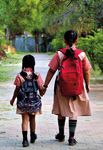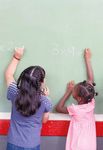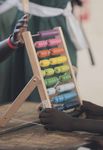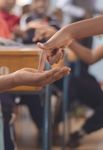Quality Education for All: Lessons and Future Priorities - PHILANTHROPY AND EDUCATION - OECD
←
→
Page content transcription
If your browser does not render page correctly, please read the page content below
PHILANTHROPY AND EDUCATION
Quality Education
for All: Lessons
and Future
Priorities
PHILANTHROPY AND EDUCATION
PHILANTHROPY AND EDUCATION
Quality Education for All:
Lessons and Future Priorities
Cite this study as: OECD netFWD (2019), “Philanthropy and Education - Quality Education For All: Lessons and Future
Priorities”, OECD Development Centre, Paris
Photo credits: Cover design by Aida Buendia (OECD Development Centre) on the basis of image from Evgeny Starkov/
Shutterstock.com
The opinions expressed and arguments employed here are the sole responsibility of the authors and do not necessarily
reflect the official views of the member countries of the OECD or its Development Centre, or of netFWD members.
© OECD 2019
This document, as well as any data and map included herein, are without prejudice to the status of or sovereignty over any
territory, to the delimitation of international frontiers and boundaries and to the name of any territory, city or area. OECD Development Centre The Development Centre of the Organisation for Economic Co-operation and Development was established in 1962 and comprises 27 member countries of the OECD and 30 non-OECD countries. The European Union also takes part in the work of the Centre. The Development Centre occupies a unique place within the OECD and in the international community. It provides a platform where developing and emerging economies interact on an equal footing with OECD members. Together, they promote knowledge sharing and peer learning on sustainable and inclusive development. The Centre combines multidisciplinary analysis with policy dialogue to help governments formulate innovative policy solutions to the global challenges of development. Hence, the Centre plays a key role in the OECD’s engagement with non-member countries. To increase the impact and legitimacy of its work, the Centre adopts an inclusive approach and engages with a variety of governmental and non-governmental stakeholders. It works closely with experts and institutions from its member countries; establishes partnerships with key international and regional organisations; and hosts networks of private-sector enterprises, think tanks and foundations working for development. The results of its work are discussed in experts’ meetings, as well as in policy dialogues and high-level meetings. They are published in a range of high-quality publications and papers for the research and policy communities. For an overview of the Centre’s activities, please see www.oecd.org/dev. OECD Network of Foundations Working for Development The Network of Foundations Working for Development (netFWD) connects foundations from across the globe to maximise the impact of philanthropy for development. netFWD’s mission is to help foundations better collaborate with governments and each other. Bringing foundations and governments closer together delivers far greater development outcomes, helps identify comparative strengths and encourages the philanthropic sector to become more transparent. Since 2012, netFWD has been an integral part of the OECD Development Centre, where foundations can gain visibility in the development arena. As the philanthropic sector contributes more ideas and innovation to tackle development challenges, the need for a platform to enable co-operation with and among foundations working for development has never been more pressing. To learn more about netFWD, please see www.oecd.org/site/netfwd.
Foreword
This policy note analyses foundations’ support for education in developing countries. It provides key figures of
philanthropic giving for education and gathers a selection of case studies to further explore how foundations
are investing to expand access to schooling, better measure learning outcomes, empower teachers and school
leaders to deliver quality education, and learn from their own work on the ground.
This policy note is part of the OECD’s efforts to bring together leaders in philanthropy, policy makers and OECD
experts to address the world’s most pressing development challenges. Since its launch in 2012, the Network of
Foundations Working for Development (netFWD) has been providing a space where those stakeholders can share
evidence and strategic insights, explore promising novel approaches, and engage in genuine partnerships.
To shed light on ways in which philanthropy supports education in developing countries, netFWD launched an
Education Working Group. This policy note builds upon insights from the first meeting of the working group in
November 2018, additional desk research, interviews and material from leading foundations working on education
in developing countries. The note is also informed by OECD Survey on Private Philanthropy for Development, and
OECD DAC statistics unpacking data on philnathropic giving from 2013-15 and 2017.
This policy note was written under the guidance of Bathylle Missika, Head of the Networks, Partnerships and
Gender Division, with inputs from Lorenzo Pavone, Deputy Head of the Networks, Partnerships and Gender
Division (OECD Development Centre).
The note was drafted by Laura Abadia, and Nelson Amaya, Policy Analysts for the OECD Network of Foundations
Working for Development (netFWD). It benefited from inputs and comments from William Thorn (OECD Education
Directorate), and colleagues in the Networks, Partnerships and Gender Division: Ewelina Oblacewicz and Luiza
Salazar Andriotti.
Special thanks to Tomáš Hos and Cécile Sangaré, from the Financing for Sustainable Development Division
(OECD Development Co-operation Directorate), for providing additional information on private philanthropy for
education, based on data reported to the OECD Creditor Reporting System in 2017.
Our appreciation goes to Mark Foss for editing assistance and to the communications and publications team of
the OECD Development Centre for their support, particularly Aida Buendia. We also wish to express our sincere
thanks to Grace Dunphy and Sonja Märki (OECD Development Centre) for their valuable assistance throughout
the drafting and publishing process.
Finally, we wish to thank all of the foundations and partners that further supported this report with their inputs:
Aga Khan Foundation, FHI 360, Franks Family Foundation, Hewlett Foundation, Instituto Ayrton Senna, Jacobs
Foundation, Learning Links Foundation, Robert Bosch Foundation, Sawiris Foundation for Social Development,
Strømme Foundation and Varkey Foundation.
PHILANTHROPY AND EDUCATION - QUALITY EDUCATION FOR ALL: LESSONS AND FUTURE PRIORITIES © OECD 2019 3
Table of contents
Foreword................................................................................................................................................................................................................ 3
Abreviations and acronyms...................................................................................................................................................................... 6
Executive summary ....................................................................................................................................................................................... 7
1_Philanthropy for Development in Education: The View from Above...................................................................... 9
2_Learning for All: How Can Philanthropy Help Fulfil a Broken Promise? ��������������������������������������������������������� 17
2.1 Better access to schooling: A first step for better learning..............................................................................................21
2.2 Measuring learning outcomes...................................................................................................................................................... 26
2.3 Investing in teachers and school leaders.................................................................................................................................31
2.4 Foundations as learning organisations: Building knowledge on effective education approaches 36
Conclusion ......................................................................................................................................................................................................... 41
Annex: OECD data on private philanthropy for development..................................................................................................... 44
Notes...................................................................................................................................................................................................................... 46
Bibliography........................................................................................................................................................................................................47
Figures
1.1. Philanthropic giving by sector 2013-15, USD........................................................................................................................ 10
1.2. International providers of finance for education in developing countries 2013-15.............................................. 10
1.3. Philanthropic giving for education by region 2013-15, USD million............................................................................ 11
1.4. Philanthropic giving for education by country 2013-15, USD million......................................................................... 11
1.5. Top foundations in education ...................................................................................................................................................... 12
1.6. Distribution of philanthropy for education 2013-15............................................................................................................ 13
1.7. ODA vs. private philanthropy for education 2013-15......................................................................................................... 14
2.1. OECD PISA 2015 results in OECD and non-OECD countries....................................................................................... 18
2.2. Net school enrolment in low income countries vs. world enrolment average, 2015
(lower tail of the distribution)........................................................................................................................................................ 21
2.3. Percentage of countries with data to monitor progress toward
the Sustainable Development Goals for learning ...............................................................................................................26
2.4. Teachers trained in secondary education, 2015 (lower tail of the distribution)..................................................... 31
2.5. Randomised evaluations in education, 2000-18.................................................................................................................. 37
Boxes
2.1. The prevailing learning gap.........................................................................................................................18
2.2. Summary of case studies: How is philanthropy moving the needle on education? .................................19
2.3. Bringing education to underserved communities..................................................................................... 22
2.4. Dismantling systemic barriers to higher education................................................................................... 23
2.5. Investing in school-based health programmes......................................................................................... 25
2.6. Helping build scalable monitoring systems in South Africa...................................................................... 27
2.7. Strengthening the equity of assessment systems ................................................................................... 27
2.8. Foundations’ support to socio-emotional learning (SEL)......................................................................... 28
2.9. Investing in teachers and school principals.............................................................................................. 32
2.10. Investing in municipalities’ technical capacities in Brazil.......................................................................... 32
2.11. Innovating with school governance and the enabling environment.......................................................... 33
2.12. M&E and action-research probes best practices in lifelong learning....................................................... 36
2.13. Learning about what works in education through field experiments........................................................ 38
PHILANTHROPY AND EDUCATION - QUALITY EDUCATION FOR ALL: LESSONS AND FUTURE PRIORITIES © OECD 2019 5
Abreviations and acronyms
BMGF Bill & Melinda Gates Foundation
CIFF Children’s Investment Fund Foundation
DAC Development Assistance Committee
DCD Development Co-operation Directorate
ESSA Education Sub Saharan Africa Initiative
FHI Family Health International
GDP Gross domestic product
INGO International non-governmental organisation
KPI Key performance indicator
LDC Least developed country
LIC Low-income country
LMIC Lower middle-income country
M&E Monitoring and evaluation
netFWD Network of Foundations Working for Development
NGO Non-governmental organisation
NGS New Generation School
OECD Organisation for Economic Co-operation and Development
PAL Network People’s Action for Learning Network
PISA Programme for International Student Assessment
PPP Public-private partnership
SDG Sustainable Development Goal
SEL Socio-emotional learning
SFSD Sawiris Foundation for Social Development
STBF Susan Thompson Buffet Foundation
UMIC Upper middle-income country
UNESCO United Nations Educational, Scientific and Cultural Organization
UNICEF United Nations Children’s Fund
6 PHILANTHROPY AND EDUCATION - QUALITY EDUCATION FOR ALL: LESSONS AND FUTURE PRIORITIES © OECD 2019
Executive summary
Many foundations recognise the remarkable contribution of education to society, as it provides individuals with skills to live
a healthy, meaningful and productive life. Moreover, education empowers people with the civic values and critical thinking
needed to contribute actively to their communities. It is therefore not surprising that many foundations see education as a
lever to promote greater social cohesion and shared prosperity in the longer term.
Overall, foundations working in developing countries are an important source of funding for education. Between
2013 and 2015, an OECD survey of 143 foundations working in developing countries revealed that philanthropy allocated
on average USD 693 million yearly towards the education sector (OECD, 2018 [1] ). In aggregate, philanthropic giving
represented the sixth largest source of funding for education towards developing countries. This made it on par with
the bilateral official development assistance (ODA) towards education provided by the United Kingdom or Japan. Higher
education received the largest proportion of philanthropic resources. Between 2013 and 2015, close to USD 549 million for
education went to scholarships, and degree and diploma programmes at universities, colleges and polytechnics. Asia and
Africa attracted most education-related giving between 2013-15, while India, Turkey and the People’s Republic of China
ranked as the top recipient countries.
However, in spite of increased attention and substantive funding, the promise of quality education for all is
yet to be fulfilled. Enrolment in pre-school and in post-primary education is growing globally, yet there is still much
scope to improve access in many developing countries.i Compounding this challenge, while primary school enrolment has
increased over the past two decadesii, millions of children complete primary education without mastering basic numeracy
and literacy skills (Uwezo, 2017[2]; ASER, 2019 [3]; USAID, RTI International, 2018 [4]; USAID, n.d. [5] ).
It is difficult, if not impossible, for foundations to navigate and shape education systems alone. Education systems
involve an often rigid and intricate ecosystem of institutions and actors operating at a large scale. Furthermore, investments
of governments and multilateral donors in education dwarf what a single foundation would ever be able to invest. In this
context, the case studies featured in this Note identify the challenges faced by foundations when working with education
systems, and the lessons learned. The case studies highlight that foundations are pursuing four broad strategies – often
simultaneously – to move the needle in favour of quality education for all:
• Filling gaps: From community schools, and accelerated learning opportunities for out-of-school children,
foundations are helping expand the supply of education services in well-delimited, deprived areas, to make
education accessible to particularly vulnerable populations.
• Innovating: Foundations are testing innovations such as early learning delivery models, pedagogies for basic
skills or teacher training methods. Some of these efforts are underpinned by rigorous monitoring and evaluation
strategies to determine objectively whether a new approach is effective and ripe for scale. However, there is still
room for many more programmes to incorporate impact evaluation.
• Co-investing: By co-investing with ODA donors, foundations are helping shape initiatives at a much larger
scale than they would ever reach on their own. In addition, there are growing examples of donor collaboratives
supporting investments in education, where foundations, high net worth individuals and private companies pool
their knowledge, expertise, networks and resources.
• Influencing and building a knowledge base: Some foundations are strengthening government monitoring
systems and injecting reliable data on student learning outcomes into the public sphere. These efforts help raise
awareness on low levels of learning and advocate for greater focus on the quality of learning. Foundations are also
pioneering research on effective approaches to improving education.
There are a number of outstanding areas which foundations supporting education could further reflect on and invest in,
including the following:
• Tackling root obstacles to schooling and learning: Understanding the source of low school participation
and poor learning, as well as those most affected, is essential to design contextually relevant solutions. Some
obstacles may be obvious – such as the lack of schools in a given area– but many others may be harder to observe.
By partnering with research teams, foundations could shed light on root obstacles to schooling and learning, such
as discriminatory gender norms and child labour.
• Testing alternative models: By funding initiatives that can run at a sizeable scale, foundations could help design
and experimentally test the effectiveness of alternative school models, such as charter schools and community
schools. Foundations could, for instance, support empirical research to evaluate which models have the potential
to go to scale without compromising their financial sustainability, inclusiveness or quality. Foundations could also
further test approaches to improve teacher professional development and support through existing government
training and mentoring systems.
• Improving collaboration: As efforts to improve socio-emotional competencies spread, clear definitions and
reliable assessments are increasingly needed. Foundations could help address these dimensions, and in particular
share lessons of successful and failed approaches aroundsocio-emotional learning.
PHILANTHROPY AND EDUCATION - QUALITY EDUCATION FOR ALL: LESSONS AND FUTURE PRIORITIES © OECD 2019 71_ Philanthropy for Development in Education: The View from Above This chapter provides an overview of philanthropic giving for education in developing countriesiii between 2013-15 and for 2017. The analysis draws on quantitative data from an OECD survey of more than 140 foundations working for development between 2013-15 (OECD, 2018[1]). It is also informed by additional data for 2017 from the OECD DAC statistics on development finance. These data include a sample of 26 of the largest foundations active in international development that report to the OECD on a regular basis (OECD, 2019[6]).iv
1_ Philanthropy for Development in Education: The View from Above
Education was the second leading sector targeted by philanthropic foundations in 2013-15
Education was the second most supported sector by foundations between 2013-15, after health and reproductive
health (Figure 1.1). With a total of USD 2.1 billion over three years, or an average of USD 693 million per year,
education represented 8.7% of total philanthropic giving for development in 2013-15 (OECD, 2018 [1] ). The
magnitude of these flows are comparable to the allocations made by the United Kingdom and Japan towards the
education sector through bilateral official development assistance (ODA) (Figure 1.2).
Philanthropic giving for education was concentrated in Asia and Africa
Between 2013-15, Asia received USD 608 million for education, or 29% of total giving for education. It was
followed by Africa, with USD 592 million (28% of total giving) (Figure 1.3). In line with the regional allocation of
giving, India received the most funding for education with USD 290 million, or 14% of total philanthropic funding
for education. It was followed by Turkey with USD 227 million and the People’s Republic of China with USD 177
million (Figure 1.4).
The data available for 2017 (OECD, 2019 [6] ) reveals a greater concentration of funding for education in Africa.
From a total of USD 329 million identified in gross disbursements (current prices), USD 241 million (73% of total
philanthropic giving for education) was directed to countries in Africa. However, India still ranked as the main
recipient country of philanthropic giving for education with USD 28 million, or 9% of total giving for education. It
was followed by Uganda with USD 24 million and South Africa with USD 21 million.
Figure 1.1. Philanthropic giving by sector 2013-15, USD
Education
2.1 billion
8.7%
Health and
reproductive health
Agriculture
12.6 billion 1.9 billion
53% 7.9%
Government
and civil society
1.7 billion
7%
Source: OECD (2018 [6] ), Survey on Private Philanthropy for Development 2013-15: Data Questionnaire, www.oecd.org/dac/financing-
sustainable-development/development-finance-standards/beyond-odafoundations.htm.
Figure 1.2. International providers of finance for education in developing countries 2013-15
Germany 2.02
International Development Association 1.95
France 1.26
EU institutions 0.76
Japan 0.61
Private Philanthropic Foundations 0.61
United Kingdom 0.57
Regional Development Banks 0.57
Norway 0.34 ODA
Canada 0.29 Private Philanthropic
Korea 0.28 Foundations
Turkey 0.23
Average per year USD billion 2013-15, commitments, current prices
Source: OECD (2018[6]), Survey on Private Philanthropy for Development 2013-15: Data Questionnaire, www.oecd.org/dac/financingsustainable-
development/development-finance-standards/beyond-oda-foundations.htm.
OECD (2019), OECD International Development Statistics: Creditor Reporting System (database), www.oecd.org/dac/stats/idsonline.htm.
.
10 PHILANTHROPY AND EDUCATION - QUALITY EDUCATION FOR ALL: LESSONS AND FUTURE PRIORITIES © OECD 20191_ Philanthropy for Development in Education: The View from Above
Figure 1.3. Philanthropic giving for education by region 2013-15, USD millionV
Europe
233
11.2%
Asia
608
29.3%
Africa
592
Global/ 28.5%
unallocated Latin
America
386
258 18.6%
12.4% Oceania
0.8 0.04%
USD million 2013-2015
Source: OECD (2018[6]), Survey on Private Philanthropy for Development 2013-15: Data Questionnaire, www.oecd.org/dac/financing-
sustainable-development/development-finance-standards/beyond-oda-foundations.htm.
Figure 1.4. Philanthropic giving for education by country 2013-15, USD million
India 165 125
Turkey 10 217
China (People's Republic of) 43 134
Brazil 29 88
South Africa 110 1
Mexico 20 66
Kenya 38 3
Bangladesh 24 Cross-border Philanthropy
Colombia 22 Domestic Philanthropy
Peru 21
USD millions 2013-15
Source: OECD (2018 [6] ), Survey on Private Philanthropy for Development 2013-15: Data Questionnaire, www.oecd.org/dac/financing-
sustainable-development/development-finance-standards/beyond-oda-foundations.htm.
Among the foundations in the survey, MasterCard Foundation was the largest philanthropic
source of funding for education
Contributions from the MasterCard Foundation represented the largest share of philanthropic funding for
education, with around USD 100 million per year, for a total of USD 301 million between 2013-15. It was followed
by Vehbi Koç Foundation, IKEA Foundation, Fundación Telefónica and Li Ka Shing Foundation. In 2017, the
MasterCard Foundation still ranked as the leading philanthropic funder, with gross disbursements of USD 164
million, followed by the Michael & Susan Dell Foundation with USD 26 million (Figure 1.5) (OECD, 2019 [6] ).
PHILANTHROPY AND EDUCATION - QUALITY EDUCATION FOR ALL: LESSONS AND FUTURE PRIORITIES © OECD 2019 111_ Philanthropy for Development in Education: The View from Above
Figure 1.5. Top foundations in education
Average per year 2013-15 (From 143 foundations)
MasterCard Foundation 100
Vehbi Koç Foundation 55
IKEA Foundation 47
Fundación Telefónica 46
Li Ka Shing Foundation 44
Children's Investment Fund Foundation 28
Tata Trusts 26
Itaú Social Foundation 21
Michael & Susan Dell Foundation 19
Turkish Educational Foundation 17
Ford Foundation 17
Open Society Foundations 16
Carnegie Corporation of New York 12
Comic Relief 12
William and Flora Hewlett Foundation 12
USD million, average per year 2013-15
Total gross disbursements 2017 (From 26 foundations)
MasterCard Foundation 164
Michael & Susan Dell Foundation 26
Carnegie Corporation of New York 19
Ford Foundation 16
Conrad N. Hilton Foundation 14
Children's Investment Fund Foundation 12
Oak Foundation 11
Omidyar Network Fund, Inc. 10
William and Flora Hewlett Foundation 9
Dutch Postcode Lottery 9
Comic Relief 8
John D. and Catherine T. MacArthur Foundation 7
Swedish Postcode Lottery 6
H&M Foundation 6
Bill & Melinda Gates Foundation 6
USD million, 2017
Source: OECD (2018 [6] ), Survey on Private Philanthropy for Development 2013-15: Data Questionnaire, www.oecd.org/dac/financing-
sustainable-development/development-finance-standards/beyond-odafoundations.htm.
OECD (2019), OECD International Development Statistics: Creditor Reporting System (database), http://www.oecd.org/dac/stats/idsonline.htm
12 PHILANTHROPY AND EDUCATION - QUALITY EDUCATION FOR ALL: LESSONS AND FUTURE PRIORITIES © OECD 20191_ Philanthropy for Development in Education: The View from Above
International philanthropy focused on higher education
Higher education received the largest proportion of philanthropic resources. Between 2013 and 2015, close
to USD 549 million for education went to scholarships, and degree and diploma programmes at universities,
colleges and polytechnics (OECD, 2018 [7] ). Education policy and administrative management ranked second,
with philanthropic resources providing USD 535 million to education ministries, institutional capacities and
school management. Vocational training received USD 140 million, while basic education received USD 326
million. The latter was mostly for primary schooling (USD 134 million) and early childhood education programmes
(USD 104 million) (Figure 1.6).
The channel through which philanthropic resources are deployed for education is known in 58% of cases
(for around USD 1.2 billion). Non-governmental organisations (NGOs) and other civil society groups received
USD 578 million (28% of total). For their part, universities, colleges, other teaching institutions and think tanks
channelled USD 476 million (23% of education giving). The intermediary organisations that received the most
philanthropic funding for education were the United Nations Children’s Fund (USD 82 million) and the World Bank
Group (USD 45 million).
Figure 1.6. Distribution of philanthropy for education 2013-15
USD
million %
Higher education 549 26
Education policy and administrative management 535 26
Education Education facilities and training 217 10
Vocational training 140 7
Primary education 134 6
Early childhood education 104 5
Teacher training 95 5
Basic life skills for youth and adults 88 4
Secondary education 83 4
Advanced technical and managerial training 81 4
Education research 53 3
Source: OECD (2018 [6] ), Survey on Private Philanthropy for Development 2013-15: Data Questionnaire, www.oecd.org/dac/financing-
sustainable-development/development-finance-standards/beyond-oda-foundations.htm.
There is a positive correlation between the scale of funding from ODA and philanthropy in
education
Philanthropy for development is highly concentrated in health and education (OECD, 2018 [1] ). Conversely, ODA is
widely distributed between many sectors that philanthropy does not address, such as transportation, energy or
debt relief. Average philanthropic flows for education between 2013 and 2015 reached USD 693 million per year.
However, average ODA for education towards all developing countries reached USD 8.5 billion per year, making
philanthropic funding in education around 8% of ODA towards education. For the 36 countries receiving both
sources of financing during this period, there is a slightly positive correlation between the scale of funding from
ODA and philanthropy in education. This means that, on average, countries receiving larger amounts of ODA also
received larger amounts of philanthropic flows. This correlation can be observed despite different magnitudes of
resource flows and varied levels of income per capita for recipients (Figure 1.7).
PHILANTHROPY AND EDUCATION - QUALITY EDUCATION FOR ALL: LESSONS AND FUTURE PRIORITIES © OECD 2019 131_ Philanthropy for Development in Education: The View from Above
Figure 1.7. ODA vs. private philanthropy for education 2013-15
Pakistan
Elasticity: exp(0.48)-1 = 0.6 Lebanon
R2: 0.26 El Salvador
Countries = 35 Ukraine
100 Malawi Nigeria
Average ODA for education 2013−2015 (Log USD million)
Cambodia Rwanda Mexico
Haiti
South Sudan
Bosnia and Herzegovina Burundi
Serbia Niger Chile
Kazakhstan
Angola Guinea Nicaragua Belarus
Fiji Kosovo Liberia
Gabon
Mauritania
Costa Rica
10 Paraguay
Turkmenistan
Namibia
Sao Tome and Principe Panama
Botswana
Bhutan Seychelles
1
0.01 0.10 1.00
Average philanthropy for education 2013−2015 (Log USD million)
Note: Bigger size reflects higher GDP per capita in 2015 (constant 2010 USD), by country. ODA figures represent period average of commitments
towards the education sector.
Note for Kosovo: This designation is without prejudice to positions on status, and is in line with United Nations Security Council Resolution
1244/99 and the Advisory Opinion of the International Court of Justice on Kosovo’s declaration of independence.
Source: OECD calculations based on OECD DAC and World Development Indicators.
14 PHILANTHROPY AND EDUCATION - QUALITY EDUCATION FOR ALL: LESSONS AND FUTURE PRIORITIES © OECD 2019© Amlan Mathur/Shuterstock.com
16 PHILANTHROPY AND EDUCATION - QUALITY EDUCATION FOR ALL: LESSONS AND FUTURE PRIORITIES © OECD 2019
2 _ Learning for All:
How Can Philanthropy
Help Fulfil a Broken
Promise?
This chapter looks into how foundations are engaging and navigating complex education systems
in developing countries. It is not an exhaustive review of foundations’ support for education, nor is it
an analysis of the effectiveness, or efficiency of this support. Rather, it compiles and analyses case
studies that illustrate how philanthropy is investing in some pillars of the education ecosystem, which
range from school infrastructure and supplies, student health and rigorous measurement of learning to
qualifications and motivation of teachers and school leaders.
PHILANTHROPY AND EDUCATION - QUALITY EDUCATION FOR ALL: LESSONS AND FUTURE PRIORITIES © OECD 2019 172 _ Learning for All: How Can Philanthropy Help Fulfil a Broken Promise
Inspired by the Millennium Development Goal (MDG) of achieving equitable access to education, significant
progress was made in getting children into schools. Under the MDGs, it was assumed that universal schooling
would translate into universal learning. Between 2000 and 2017, the number of out-of-school children fell by
114 million, a 30% drop from 376 million (UIS, 2019 [8] ). Nonetheless, evidence suggests important quality gaps
between OECD and non-OECD countries (Box 2.1). In many countries, particularly in Africa and Asia, millions
of children are completing primary education without acquiring the most basic academic skills (Uwezo, 2017[2];
ASER, 2019 [3]; USAID, RTI International, 2018 [4]; USAID, n.d. [5] ). With the advent of the Sustainable Development
Goals (SDGs), education partners, ODA providers and foundations have shifted their focus to one of quality,
specifically looking to achieve ‘’inclusive, equitable quality education for all’’ (SDG4).
With funding and technical expertise, foundations are becoming full-fledged partners in the ambitious 2030
Sustainable Development Agenda. However, providing inclusive opportunities for lifelong learning in developing
countries requires making significant headway against deep structural challenges. Obstacles include
overambitious and rigid national curricula and weak data collection systems, pockets of low enrolment and
high truancy rates, few opportunities for early- and post-primary education, overcrowded classrooms with often
unprepared teachers, and weak school leadership (World Bank, 2018 [9] ). How can foundations, whose budgets
are dwarfed by government and ODA spending in education, best play to their comparative advantage and
contribute to improving education systems? How can philanthropy contribute to system change? What are
effective initiatives to increase access and learning outcomes, and what are priority areas for future investments?
The case studies presented below highlight initiatives whose objectives are to expand access to schooling
(section 2.1), better measure and improve learning outcomes (section 2.2), and empower teachers and school
leaders (section 2.3). The note also provides examples of how foundations are themselves learning from their
own work in education (section 2.4).
Box 2.1. The prevailing learning gap
Relative performance in standardised tests shows a persistent gap between average results in OECD and
non-OECD countries (Figure 2.1). The latest iteration of the Programme for International Student Assessment
(PISA) was carried out in 72 countries in 2015 (OECD, 2016 [28] ). It shows 15-year-old school students in non-
OECD countries were, on average, less proficient than those in OECD countries in mathematics, reading and
science. This comparison does not include countries in sub-Saharan Africa as these countries have not been
incorporated into PISA. However, the gaps in proficiency between students in this region and those in OECD
countries are probably much wider. A recent harmonisation of data on standardised tests worldwide concluded
that students who perform best in developing countries still “perform worse than the bottom performers in
developed countries” (Altinok, Angrist and Patrinos, 2018 [69] ). These findings add to the growing evidence that
students in some developing countries have not reached minimum competencies in literacy and numeracy after
many years of schooling (Pritchett, 2013 [82]; World Bank, 2018, pp. 71-89 [9] ).
Figure 2.1. OECD PISA 2015 results* in OECD and non-OECD countries
Average results by test for PISA 2015, by country
OECD countries Non−OECD partner countries
Mathematics Reading Science
500
400
10 30 100 10 30 100 10 30 100
Log GDP per capita PPP in 2015 (current international USD thousands)
*Ordinary least squares fitted line, for each group of countries, and each type of test.
18 PHILANTHROPY AND EDUCATION - QUALITY EDUCATION FOR ALL: LESSONS AND FUTURE PRIORITIES © OECD 20192 _ Learning for All: How Can Philanthropy Help Fulfil a Broken Promise
Box 2.2. Summary of case studies: How is philanthropy moving the needle on education?
Improving access Investing in skills Empowering Building the
to schooling and measuring teachers and evidence base
learning outcomes school leaders
Foundations Foundations are
are investing in Foundations Foundations are pioneering research
community-based are investing in supporting in-service on effective
education and reliable metrics training for teachers approaches to
school-based health and information and education improve education.
programmes to systems on student administrators, and Examples include
improve enrolment learning, supporting experimenting with cross-country
and attendance. In effective pedagogic new school models longitudinal research
Africa, foundations approaches that can potentially and rigorous
are working with to strengthen improve school impact evaluation
governments to foundational skills governance. of education
improve accessibility and going beyond the programmes.
to a still sparse tertiary -----------------------
basics by promoting
-----------------------
education system. programmes on Upskilling teachers
socio-emotional and school leaders Developing a
-----------------------
learning. in Argentina, cross-country
Building community and India (Varkey longitudinal study
-----------------------
schools in Foundation, Learning to learn from early
Egypt (Sawiris Partnering with Links Foundation). childhood providers,
Foundation for Social government schools and youth
Development). Investing in development
to strengthen
municipalities’ partners that improve
the education
Offering technical
monitoring system learning outcomes
accelerated learning capacities in Brazil
in South Africa in some of the
opportunities for (Fundação Itaú
(Michael & Susan most marginalised
out-of-school Social).
Dell Foundation). environments
children in West
Innovating with (Schools 2030 donor
Africa (Strømme Supporting citizen-
school governance collaborative).
Foundation, Legatum led assessments
Foundation, through charter Supporting
of children’s
Turing Foundation, schools in South- action-research
basic numeracy
Norwegian Kavli Trust, East Asia (Franks to facilitate the
and literacy skills
AKO Foundation). Family Foundation). transition of
(William & Flora
Hewlett Foundation). education pilots
Investing in school-
to scale in Côte
based health Defining, measuring d’Ivoire (Jacobs
programmes in and investing in Foundation).
Africa and Asia socio-emotional
(Children’s Investment learning (Funders’ Investing in
Fund Foundation). Collaborative rigorous impact
for Innovative evaluation
Dismantling
Measurement, Ayrton (Children’s
systemic barriers to
Senna Institute, Investment Fund
higher education in
FHI 360). Foundation, Echidna
Africa by compiling
Giving, MasterCard
unprecedented
Foundation, Douglas
data on current and
B. Marshall Jr.
future demand for
Family Foundation,
faculty (Education
MacArthur
Sub Saharan Africa,
Foundation).
Jacobs Foundation,
MasterCard
Foundation, Schaufler
Foundation).
PHILANTHROPY AND EDUCATION - QUALITY EDUCATION FOR ALL: LESSONS AND FUTURE PRIORITIES © OECD 2019 19© Monkey Business Images/Shuterstock.com 20 PHILANTHROPY AND EDUCATION - QUALITY EDUCATION FOR ALL: LESSONS AND FUTURE PRIORITIES © OECD 2019
2 _ Learning for All: How Can Philanthropy Help Fulfil a Broken Promise
2.1 Better access to schooling: A first step for better learning
Although significant progress has been made towards universal primary education, pockets of low enrolment persist
(Figure 2.2). School fees and the opportunity cost of education – for example, the output lost (in the market or
household sector) due to children’s attendance at school – are still common barriers to schooling.
Figure 2.2. Net school enrolment in low income countries vs. world enrolment average, 2015
(lower tail of the distribution)
Net enrolment rate, female (%) Net enrolment rate, male (%)
Primary school enrolment Secondary school enrolment
0 20 40 60 80 100 0 20 40 60 80 100
World World
Marshall Islands Malawi
Eswatini Sierra Leone
Pakistan Mali
Gambia Ethiopia
Senegal Madagascar
Solomon Islands Burundi
Burkina Faso Eritrea
Niger Burkina Faso
Sudan Mauritania
Djibouti Mozambique
Mali Chad
Equatorial Guinea Niger
Eritrea Liberia
Source: World Bank (2019), World Development Indicators (database). http://datatopics.worldbank.org/world-development-indicators.
Addressing the visible barriers to education: Geography and cost
On average, in rural regions in sub-Saharan Africa, one out of three children are out-of-school (UIS, 2019 [10] ). In
these areas, which are generally sparsely populated, children must often travel longer distances to reach the
nearest school. This can be a barrier to schooling, particularly for girls if safety concerns and social norms make
it difficult for them to commute far from home (Kremer, Brannen and Glennerter, 2013 [11] ). Some foundations are
supporting community schools as an alternative to primary education in areas, or for specific populations, that
would otherwise have no access to conventional public schooling (Box 2.3).
By covering the upfront costs of establishing new schools, and working with local education NGOs, foundations
can bring education services to remote, rural communities in a relatively short time. Through these schools,
foundations can also tailor education services to meet the needs of the students they serve (Marchand, 2000 [12] ).
For example, community schools generally recruit teachers from the community. Such teachers, unlike those
from conventional public schools, are more likely to share a common background and language with their
students (DeStefano and Moore, 2010 [13; Miller-Grandvaux and Yoder, 2002 [14] ). Children’s mother tongue is not
always the same as the official language of instruction. In these cases, a teacher who can understand and more
easily relate to children and their families can positively influence learning (UNESCO, 2016 [15]; UNESCO, 2008 [16] ).
In addition, through novel pedagogies, community schools can offer different learning experiences to those
provided by regular public schools (Marchand, 2000 [12] ).
Community-based solutions can also benefit from greater flexibility to provide targeted services for particularly
vulnerable populations. This is the case of ‘’bridge classes’’, which enable out-of-school children to follow an
accelerated course as a bridge into the formal school system. This approach has received significant support
from foundations. They have funded the piloting, evaluation and roll-out of bridging classes in Burkina Faso, Mali
and Niger, as well as their replications in other contexts in East Africa and the Middle East (Box 2.3).
There is one essential difference between community schools and bridging classes. Community schools replace
regular public schools in underserved areas while, bridging classes bring out-of-school children into regular public
education, and are generally established near an existing public school. Yet, through both models, foundations
PHILANTHROPY AND EDUCATION - QUALITY EDUCATION FOR ALL: LESSONS AND FUTURE PRIORITIES © OECD 2019 212 _ Learning for All: How Can Philanthropy Help Fulfil a Broken Promise
collaborate closely with governments. Such collaboration is necessary as national education authorities set
curricula for the classroom, and government monitors supervise teaching in the schools. Both approaches are
also designed to be temporary. In the example below, community schools receive philanthropic support for up
to seven years before being transferred to government, which takes over the running costs. Similarly, bridging
classes are typically established in a village for two years. Each bridge course also sets up a school management
committee, which oversees teacher and student attendance and raises awareness in the community about the
importance of education. This committee stays after the bridge course ends, and continues to encourage parents
to send their children to school.
Box 2.3. Bringing education to underserved communities
Investing in schools’ infrastructure and providing education services in underserved areas in Egypt
Egypt has made important strides towards universal primary education with a net enrolment rate of 99%
(UIS, 2019 [8] ). However, this figure hides stark disparities. In 2012, girls in rural Upper Egypt represented half of
total children aged 10-17 across the country who never went to school (Elbadawy, 2014 [17] ). Through the Schools
for Egypt Initiative, the Sawiris Foundation for Social Development (SFSD), in partnership with Star Care Egypt,
Sherouk Misr and Orascom Construction PLC, established 60 community primary schools in remote villages in
Assiut, Sohag and Qena, three governorates in Upper Egypt.
While the SFSD and its partners are helping improve the supply of education in underserved areas, they are not
substituting for government. Public education authorities retain stewardship, as they set the curriculum and, jointly
with their philanthropic partners, recruit teachers from the community. In the case of SFSD, the foundation covers
the school set-up costs and initial running costs for the first few years. This comprises three years for teachers’
salaries and seven years for teachers’ training costs. The Ministry of Education signed an agreement committing
to fund the running costs of the community schools in the middle term. At the end of this period, public authorities
thus take over education services, including paying for teacher salaries and training. However, few other initiatives
in Egypt have received a government commitment to cover the community schools’ running costs.
Community schools also aim to tailor teaching to children’s special needs. In these schools, multi-grade
classrooms are commonplace, with children from two or more grades sitting in the same classroom. Therefore,
training focuses on helping teachers manage heterogeneous classrooms. The programme is also training teachers
in accelerated learning techniques, where they can transfer fast-learners to higher grades more quickly.
Offering bridging classes for out-of-school children
In 2004, 3.4 million children of primary school age were not enrolled in school in Burkina Faso, Mali and Niger
(UIS, 2019 [18] ). To help address this issue, Norway’s Strømme Foundation launched the Speed School programme
in some rural villages in the three countries.
Speed School was designed to respond to the needs of out-of-school children in sub-Saharan Africa. It condenses
three academic years into nine months, to help children quickly catch up and reintegrate formal education.
Together with local NGOs, Strømme Foundation West Africa trains teachers, who are generally recruited from the
community. It provides basic classroom supplies, while local communities contribute with a temporary classroom.
The Hewlett Foundation funded an external impact evaluation of this programme in Mali. It showed that Speed
Schools led to significant improvements in numeracy and literacy skills, helping two out of three students catch
up and re-enter the public school system.VI
Based on the early success of the programme, other foundations have provided catalytic funding to scale
the approach in the three countries. This allowed for more than 150 000 out-of-school children to complete
the programme between 2004 and 2018. Participating foundations included the Legatum Foundation, Turing
Foundation, Norwegian Kavli Fund, AKO Foundation and bilateral co operation agencies, such as the Norwegian
Agency for Development Cooperation. The Legatum Foundation replicated the approach in Ethiopia in 2011
and, three years later, created the Luminos Fund. This pooled fund provides accelerated learning opportunities
to the most marginalised children in Ethiopia, Liberia and Lebanon. Partners of this new venture include the
Legatum Foundation, Dubai Cares, Cartier Philanthropy, UBS Optimus Foundation, Mulago, the Hirschmann
Stiftung and the Peter Cundill Foundation.
22 PHILANTHROPY AND EDUCATION - QUALITY EDUCATION FOR ALL: LESSONS AND FUTURE PRIORITIES © OECD 20192 _ Learning for All: How Can Philanthropy Help Fulfil a Broken Promise
By working at the fringes of the education system, foundations are helping address enrolment gaps in targeted
areas or for marginalised populations. However, sustaining a good number of high quality community schools may
be challenging in the longer term. On the one hand, if foundations and external donors establish new schools at a
pace that bypasses government’s financial and management capacity, the schools may face unreliable financing
or poor administration once handed over to government (Hoppers, 2005 [19] ). On the other hand, if community
schools rely solely on external or private funding, either from philanthropy, ODA or community contributions,
affordable education services in underserved areas will depend on the continued availability of these funds
(DeStefano and Moore, 2010 [13] ). This creates dependency and may undermine the government’s control over
education services. Finally, community-based solutions with local instructors or volunteers may not be replicable
at higher levels of education, where more complex curricula requires more qualified teachers.
Access to higher education deserves particular attention. Across contexts, enrolment in higher education
remains relatively low when compared to enrolment in primary and secondary school (World Bank, n.d. [20] ). This
is particularly glaring in sub-Saharan Africa, where the gross enrolment rate of 9% (8% for women and 11% for
men) is the lowest in the world. It represents just one-quarter of the global average of about 36% (UIS, 2019 [18] ).
These numbers hide an important trend, however: while enrolment remains low on absolute terms, it has doubled
over the past two decades (World Bank, n.d. [20] ). Furthermore, enrolment in higher education is expected to
increase as the bulge of primary school students continues its way through the system.
Foundations have widely used scholarships to reduce the financial barriers to participation in higher education
(OECD, 2018 [1] ). Research in the United States has shown that scholarships can increase college enrolment and
persistence (Angrist et al., 2016 [21] ). Similarly, there are a number of studies in developing countries, showing
that financial incentives can improve participation and attainment in education (Angrist, Bettinger and Kremer,
2006 [22]; Al-Samarri and Zaman, 2006 [23]; Attanasio, Meghir and Santiago, 2011[24] ).
However improvements to access do not necessarily ensure the adequate provision of higher education services.
Addressing the lack of individuals qualified to take up university teaching positions can be a lever to improve the
supply of higher education (Hénard, 2010 [25]; World Bank, 2011[26] ). The Education Sub Saharan Africa Initiative
illustrates how foundations are partnering with governments to understand the current and future demographics
of faculty, and feed data to inform scholar training and recruitment policies (Box 2.4).
Box 2.4. Dismantling systemic barriers to higher education
In 2016, the Robert Bosch Foundation provided seed funding to the Education Sub Saharan Africa Initiative
(ESSA), an independent charity striving to develop tertiary education in the region. Since its launch, other
donors have joined the initiative, including the Jacobs Foundation, the MasterCard Foundation and the
Schaufler Foundation.
Many governments lack comprehensive data on the state of faculty, or the capacity to model anticipated
growth in demand and future faculty skills needed by specialisation. Against this backdrop, in 2017, ESSA
joined forces with the Association of African Universities, a pan-African membership organisation of more
than 400 universities, and the Population Reference Bureau. Together, they launched the Demographics
of Faculty programme, which aims to compile unprecedented data needed to analyse current and future
demand for faculty and its financial implications.
The first pilot was launched in Ghana as a partnership with the African Association of Universities, the
National Council of Tertiary Education and the MasterCard Foundation. They collected and analysed data
from more than 200 Ghanaian tertiary institutions, providing a snapshot of the state of faculty staff. Using
these statistics, the initiative forecasted how the situation might evolve by 2025. It thus identified potential
pipelines for the recruitment, development and retention of scholars.
Compiling data and creating an appropriate methodology for analysis has allowed ESSA to shape the
conversation around higher education, placing a stronger focus on the need for better supply of academics
and teachers. The availability of such evidence can lay the groundwork for more relevant, longer-term
investments in high-quality faculty. In the short term, project partners, the Ghanaian government and
other higher education stakeholders are working together on the development of digital tools to forecast
recruitment and budget needs, as well as concrete scholar training and recruitment policies.
PHILANTHROPY AND EDUCATION - QUALITY EDUCATION FOR ALL: LESSONS AND FUTURE PRIORITIES © OECD 2019 232 _ Learning for All: How Can Philanthropy Help Fulfil a Broken Promise
© Agarianna76/Shuterstock.com
24 PHILANTHROPY AND EDUCATION - QUALITY EDUCATION FOR ALL: LESSONS AND FUTURE PRIORITIES © OECD 20192 _ Learning for All: How Can Philanthropy Help Fulfil a Broken Promise
Addressing less visible constraints to schooling: Household education, health and income
Accessibility is a necessary, albeit insufficient, step to have children attend and learn in school. Educated,
financially stable and healthy families are more likely to provide children with the resources and support they
need to attend and perform well in school (UNESCO, 2016 [27]; OECD, 2016 [28]; Thomson, 2018 [29]; Filmer and
Pritchett, 1999 [30] ). Household education, income and health can thus also indirectly affect schooling.
Foundations that seek to improve access to education are also investing in the communities in which they work.
For example, SFSD’s Schools for Egypt Initiative aims to enhance the economic, educational and health conditions
of the communities where the schools it supports are located. The initiative is upgrading the health units in these
areas and implementing economic empowerment programmes for families in the same communities. Similarly,
the Speed School programme invests to improve the children’s family environment. It invites mothers of students
to join self-help groups for mutual support, adult literacy programmes and microenterprise projects.
At the individual level, student malnourishment and illness can result in high truancy rates and affect children’s
capacity to effectively learn (Glewwe and Miguel, 2008 [31] ). Foundations are investing to improve health conditions
that affect primary school enrolment and performance. A notable example is the roll-out of school-based
deworming in heavily affected countries (Box 2.5).
Box 2.5. Investing in school-based health programmes
The Children’s Investment Fund Foundation (CIFF) is investing to scale deworming programmes in countries with
high prevalence of worm infections. Repeated infections can affect children’s nutritional uptake, and result in
lethargy, anaemia, malnourishment and stunting. They can increase school absenteeism, and impair the cognitive
development of young children. Rigorous impact evaluations have shown that the distribution of deworming pills
in primary schools can be a cost-effective strategy to improve health and school attendance in endemic areas
(Kremer and Miguel, 2007[32]; Miguel and Kremer, 2004 [33] , Ozier, 2019 [34] , 2011[35]; Baird, 2016 [36] ).
The benefits of deworming treatment go beyond schooling. In the long term, deworming is associated with higher
enrolment rates in secondary school for girls, and better job productivity for boys.vii Deworming medicine is
cheap, costing only a few USD cents per tablet. Moreover, deworming programmes can take advantage of school
infrastructure and train teachers to deliver the treatment to students.
To scale deworming efforts in Kenya, India and Ethiopia, CIFF is providing financial and technical support to
national governments and other operational partners like Evidence Action and its Deworm the World Initiative.
CIFF is also investing in scientific and operational research to test different methods of breaking the transmission
of worms.
These examples illustrate how foundations are supporting initiatives to address barriers to schooling. Some
obstacles are visible, such as geography, lack of qualified faculty or schooling fees. Others are less visible, such
as those related to children’s health and family environment. In the future, foundations could further engage
to identify and address rooted barriers to access and persistence in school. These include obstacles such as
discriminatory gender norms (e.g. early marriage), child labour, parents’ beliefs in the returns to education and
other opportunity costs of schooling.
PHILANTHROPY AND EDUCATION - QUALITY EDUCATION FOR ALL: LESSONS AND FUTURE PRIORITIES © OECD 2019 25You can also read


























































